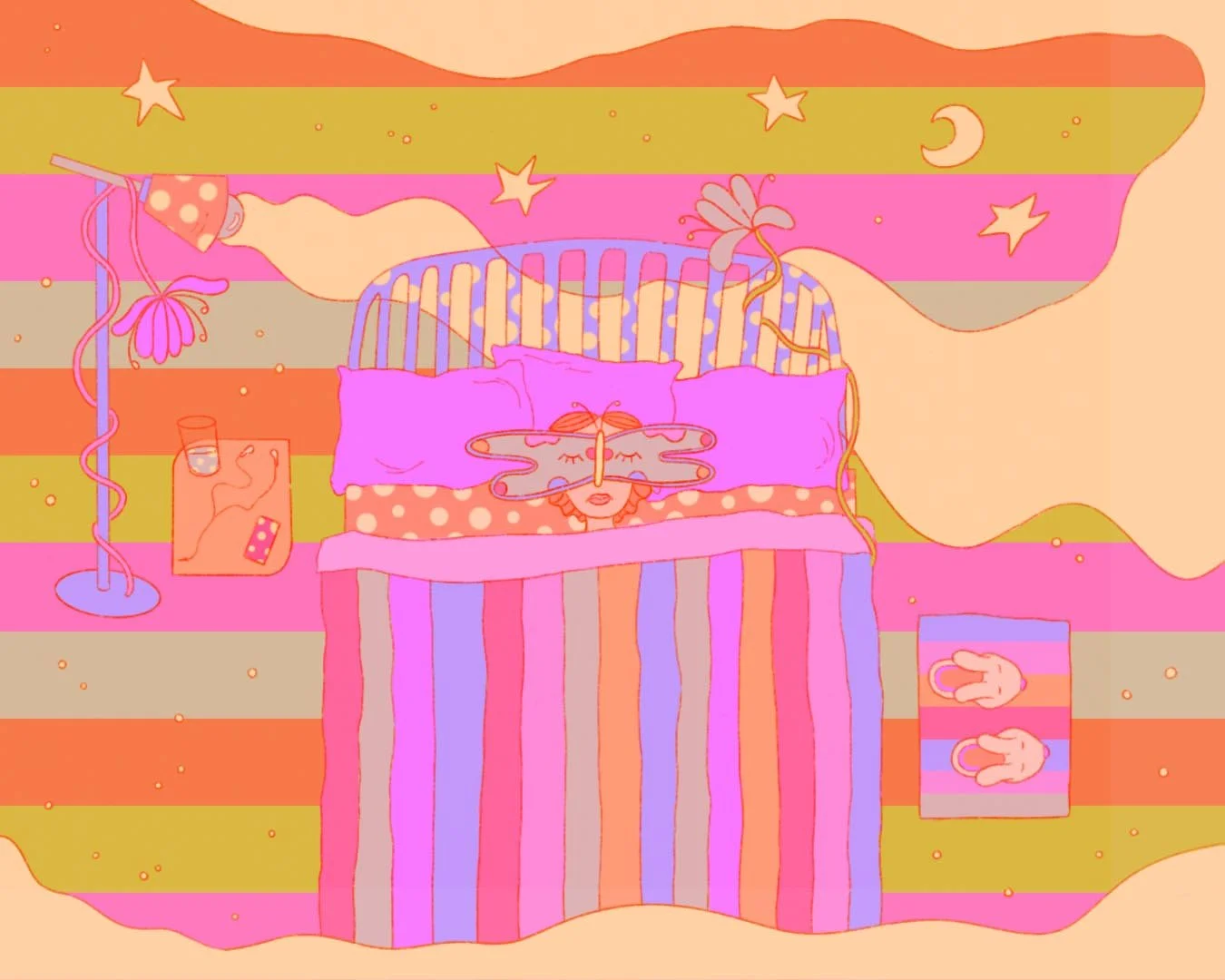Dreams that build our world
Artwork by Emma Conte
There’s this weird badge of honour floating around creative circles: the all-nighter.
We glamorize staying up late, chugging coffee, and pushing through exhaustion as if creativity only happens at 3 a.m. But here’s the thing, history shows us the opposite.
Some of the most groundbreaking ideas didn’t come from endless nights awake… they came from sleep. Real,
drooling-on-the-pillow,
brain-offline,
lights-out sleep.
Yep. Dreams have literally shaped art, science, and even the way you thread a needle.
So, if you’ve ever felt guilty about sleeping in or choosing a nap over Netflix, here’s your permission slip. Let’s look at a handful of brilliant minds who let sleep work for them, then brought their wildest dreams into reality.
Mary Shelley: Frankenstein and the Birth of Sci-Fi
Picture it: a stormy summer in 1816, Mary Shelley and her friends (including Lord Byron) challenge each other to write ghost stories. Shelley struggles at first. Then one night, she dreams of a pale scientist kneeling beside the “hideous phantasm of a man” he had pieced together only to see it spring to life.
When she woke, she wrote the bones of Frankenstein, a book that launched the entire genre of science fiction. Not bad for one night’s dream.
Sometimes, your best ideas come when you stop forcing them and let your subconscious play.
Salvador Dalí: The Key to Surrealism
Dalí didn’t just wait for dreams, he hacked them.
The surrealist painter famously used what he called “slumber with a key.” Here’s how it worked: Dalí sat in a chair with a heavy key in his hand. As he drifted off, the key would fall, clatter to the floor, and wake him up, just in time to catch the dream images floating through his half-asleep brain.
Those bizarre melting clocks and dreamlike landscapes? Straight out of his nap-inspired visions, painted into The Persistence of Memory.
Naps aren’t laziness, they can be part of your creative process.
Dmitri Mendeleev: The Periodic Table in a Dream
Science owes a lot to sleep, too. In 1869, chemist Dmitri Mendeleev struggled with organizing the known elements. He spent sleepless nights trying to find the logic. Then, exhausted, he fell asleep at his desk.
In a dream, he saw the elements falling into place in a perfectly ordered table. When he woke, he sketched it out and that became the Periodic Table of Elements we still use today.
Even science’s most logical breakthroughs can come from letting your brain wander in dreamland.
Elias Howe: Sewing Machine Needles and Dream Spears
Back in the 1840s, Elias Howe was trying to invent a sewing machine but couldn’t figure out how the needle should work. He was stuck until he dreamed of being chased by warriors carrying spears with holes near their tips. When he woke, he realized the needle should have its eye near the point, not the top.
That small shift? It made the sewing machine possible, revolutionizing fashion, textiles, and how we live today.
Sometimes the brain gifts you a metaphor in your sleep. Don’t ignore it. It might be the solution.
James Cameron: The Terminator in a Nightmare
Even Hollywood owes a debt to dreams. James Cameron, while sick with a fever, dreamed of a metallic skeleton dragging itself from the flames. Creepy, right? But that image became the seed of The Terminator, one of the most iconic sci-fi films ever.
Nightmares aren’t always bad, they might be creative gold.
So why does sleep do this? According to Matthew Walker’s book Why We Sleep, our brain at night isn’t just “resting.” It’s actually working behind the scenes, filing memories, connecting dots, and mixing ideas in ways our awake brain can’t.
Walker describes REM sleep (the dream-heavy stage) as a sort of overnight therapy and creativity lab. It loosens rigid thinking patterns, allows the brain to remix ideas, and hands you fresh insights by morning. Which explains why Mary Shelley, Mendeleev, and Cameron woke up with solutions, or entire stories, in their heads.
Pulling an all-nighter? That short-circuits this process. You might finish a project, but you won’t give your brain the chance to generate truly original ideas. Sleep is the real secret weapon.
So, Should Creatives Sleep More?
Absolutely. Sleep isn’t wasted time. It’s creative time. The problem is, because it happens behind the scenes, we undervalue it. But if you’re serious about ideas, you need to take your sleep as seriously as your work.
Here are a few practical ways to use sleep as part of your creative toolkit:
Keep a notebook by your bed. Dreams fade fast. Write them down the moment you wake.
Nap with intention. Like Dalí, try short naps to spark ideas.
Don’t fight blocks with more coffee. Walk away, rest, and trust your brain will work in the background.
Protect your REM sleep. That means 7–9 hours, ideally consistent, so your brain cycles through the stages properly.
Mary Shelley, Dalí, Mendeleev, Howe, and James Cameron prove that sleep isn’t the enemy of creativity, it’s the source of it. Their dreams literally changed literature, art, science, technology, and film.
So the next time you’re tempted to stay up all night forcing inspiration, remember: the greatest ideas might come not when you’re grinding, but when you’re dreaming.
Close the laptop. Turn off the light. Let your brain do its secret work.
Who knows, your next masterpiece might already be waiting for you in your dreams.
Best Wishes,
Cosmos Creatives
